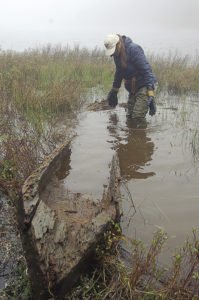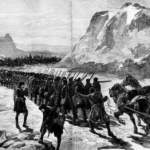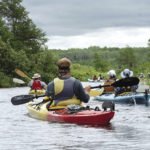Remnants at a logging camp near Hurkett, Ontario. | KATHY TOIVONEN
Hurkett—For context, it must be noted that prisoner of war (POW) camps detained German army officers, German soldiers, and interned Japanese and Italian immigrants. From these camps, enlisted German soldiers, who were considered to be a low risk for escape, were offered a choice to work in logging camps.
During World War II, there was a fear that Germany could be successful in its campaign against Britain and thereby release the German prisoners who might have useful intelligence to report. Therefore, as a dominion of Britain, Canada was chosen as a holding place for the prisoners. POW camps were set up in B.C., Alberta and Ontario on the North Shore of Lake Superior.
Because many Canadian men went off to war, a labour shortage was created in industries such as farming and logging. As a result, in 1943, Canada’s Labour Minister, Humphrey Mitchell, authorized employment for the low risk German soldiers. Men were shipped to Northwestern Ontario by rail from POW camps, mostly from Lethbridge and Medicine Hat, Alberta. Hundreds of men were brought to remote logging operations throughout the region. The prisoners were paid a small amount for their labour and they were expected to produce a minimum of three-quarters to one cord (4’x4’x8’) of wood per day.
While doing research for a book project, I discovered many stories on POW logging camps in the area and one very interesting artifact.

In contrast to the highly secured, fenced POW camps, family stories and historical references described the logging camps as having little to no security. After their quota of work was done, the prisoners were free to do as they wish. One story of a camp near Upsala tells of the prisoners who would walk into town to watch a movie and then go back to the camp. Another anecdote describes a group of prisoners who built a cabin where they often stayed for the weekend. Fishing was a favourite pastime for many of the men, and some even took to making canoes from dug-out logs.
During the interview process for the book, I was shown where there was a dug-out canoe, made by German POWs, hidden under the water at a lake near an old logging camp site close to Hurkett, Ontario. So my partner in the book project, Kim Manduca, and I set out to find the canoe. A short forest trail led to the edge of a muskeg swamp before reaching the water’s edge. With rubber boots and walking sticks, we soldiered on into the bog, poking at the bottom in hopes of finding the canoe. It was unmistakable when the stick hit the solid mass about two feet under the murky water. I could feel the shape of the canoe, but the hollow was mostly filled with muskeg; so I scooped out the debris and could then confirm the mass as a hollowed out log. We levered the canoe with a stick while lifting it with a strap until the waterlogged artifact broke the surface. We were able to pull most of the canoe out of the water, which was enough to get beautiful photographs. Afterwards, we let the canoe sink back into the swamp to stay preserved in its watery grave.




